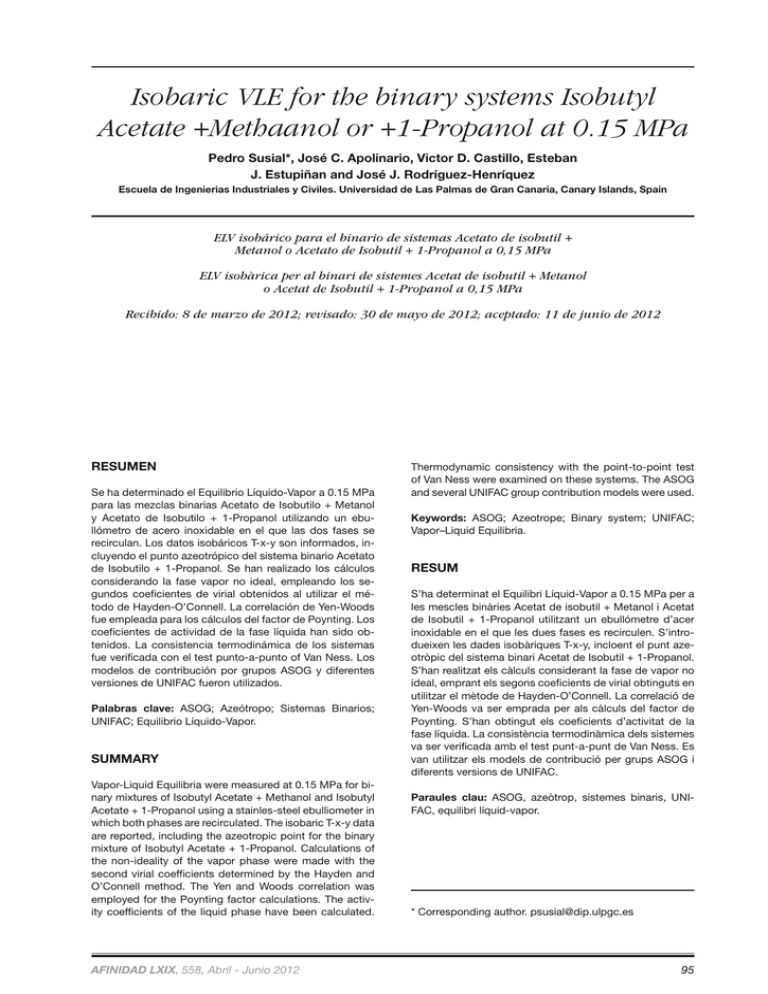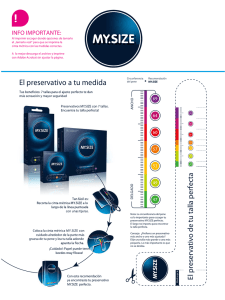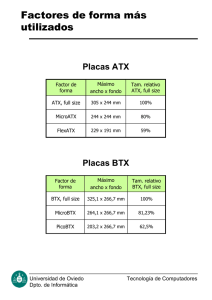T - Raco
Anuncio

Isobaric VLE for the binary systems Isobutyl Acetate +Methaanol or +1-Propanol at 0.15 MPa Pedro Susial*, José C. Apolinario, Victor D. Castillo, Esteban J. Estupiñan and José J. Rodríguez-Henríquez Escuela de Ingenierias Industriales y Civiles. Universidad de Las Palmas de Gran Canaria, Canary Islands, Spain ELV isobárico para el binario de sistemas Acetato de isobutil + Metanol o Acetato de Isobutil + 1-Propanol a 0,15 MPa ELV isobàrica per al binari de sistemes Acetat de isobutil + Metanol o Acetat de Isobutil + 1-Propanol a 0,15 MPa Recibido: 8 de marzo de 2012; revisado: 30 de mayo de 2012; aceptado: 11 de junio de 2012 RESUMEN Se ha determinado el Equilibrio Líquido-Vapor a 0.15 MPa para las mezclas binarias Acetato de Isobutilo + Metanol y Acetato de Isobutilo + 1-Propanol utilizando un ebullómetro de acero inoxidable en el que las dos fases se recirculan. Los datos isobáricos T-x-y son informados, incluyendo el punto azeotrópico del sistema binario Acetato de Isobutilo + 1-Propanol. Se han realizado los cálculos considerando la fase vapor no ideal, empleando los segundos coeficientes de virial obtenidos al utilizar el método de Hayden-O’Connell. La correlación de Yen-Woods fue empleada para los cálculos del factor de Poynting. Los coeficientes de actividad de la fase líquida han sido obtenidos. La consistencia termodinámica de los sistemas fue verificada con el test punto-a-punto of Van Ness. Los modelos de contribución por grupos ASOG y diferentes versiones de UNIFAC fueron utilizados. Palabras clave: ASOG; Azeótropo; Sistemas Binarios; UNIFAC; Equilibrio Líquido-Vapor. SUMMARY Vapor-Liquid Equilibria were measured at 0.15 MPa for binary mixtures of Isobutyl Acetate + Methanol and Isobutyl Acetate + 1-Propanol using a stainles-steel ebulliometer in which both phases are recirculated. The isobaric T-x-y data are reported, including the azeotropic point for the binary mixture of Isobutyl Acetate + 1-Propanol. Calculations of the non-ideality of the vapor phase were made with the second virial coefficients determined by the Hayden and O’Connell method. The Yen and Woods correlation was employed for the Poynting factor calculations. The activity coefficients of the liquid phase have been calculated. Afinidad LXIX, 558, Abril - Junio 2012 Thermodynamic consistency with the point-to-point test of Van Ness were examined on these systems. The ASOG and several UNIFAC group contribution models were used. Keywords: ASOG; Azeotrope; Binary system; UNIFAC; Vapor–Liquid Equilibria. RESUM S’ha determinat el Equilibri Líquid-Vapor a 0.15 MPa per a les mescles binàries Acetat de isobutil + Metanol i Acetat de Isobutil + 1-Propanol utilitzant un ebullómetre d’acer inoxidable en el que les dues fases es recirculen. S’introdueixen les dades isobàriques T-x-y, incloent el punt azeotròpic del sistema binari Acetat de Isobutil + 1-Propanol. S’han realitzat els càlculs considerant la fase de vapor no ideal, emprant els segons coeficients de virial obtinguts en utilitzar el mètode de Hayden-O’Connell. La correlació de Yen-Woods va ser emprada per als càlculs del factor de Poynting. S’han obtingut els coeficients d’activitat de la fase líquida. La consistència termodinàmica dels sistemes va ser verificada amb el test punt-a-punt de Van Ness. Es van utilitzar els models de contribució per grups ASOG i diferents versions de UNIFAC. Paraules clau: ASOG, azeòtrop, sistemes binaris, UNIFAC, equilibri líquid-vapor. * Corresponding author. [email protected] 95 INTRODUCTION The modelling of phase equilibria have been one of the most compelling problems of chemical engineering. Even though a great variety of methods have been developed to understand and design the different separation processes of substances, these models exhibit certain limitations in their predictions, mostly for complex mixtures and for those processes that take place at over-atmospheric pressures. Distillation is one of the most important processes in chemical industries. As a consequence of the limitations presented by the prediction models, experimental vapor liquid equilibria (VLE) data are needed for the dimensioning of the equipments required for this unit operation. This is particularly necessary for substances such as esters or alcohols, which must be provided with high purity degrees for many processes and industries. using a Pt-100 probe with a digital Dostmann Electronic P655 thermometer. The Pt-100 probes were calibrated by Dostmann Electronic GmbH following laboratory standards calibration procedures, according to the international NPL and NIST standards. Pressure was maintained at 0.15 MPa through a controller valve of Binks MFG Co. Working pressure was measured using a pressure transmitter with a 0.0 to 4.0 MPa range (uncertainty of ±0.002 MPa) of Burket Fluid Control Systems, model 8311. Equilibrium was usually reached after 1.5 h. After this, small volumes of samples from the equilibrium phases were collected in external sealed recipients and were analyzed with a density meter at 298.15 K. A calibration curve composition vs. density had been previously obtained. The greatest uncertainty found for these systems with this method of composition analysis was better than 0.002 units in the vapour and liquid phase mole fraction. Table 1: Physical properties of pure substances and literature data. This is the reason why, using like in previous works (Susial et al., 2010a) a dynamic ebulliometer, we have determined VLE data corresponding to the systems isobutyl acetate + methanol (IBAM) and isobutyl acetate + 1-propanol (IBAP) at 0.15 MPa. We have only found the system IBAM at 101.3 kPa in literature (Resa et al., 1998). The azeotrope of the IBAP system has not been found to be described in bibliography. Consequently, in order to verify the quality of the experimental data obtained in this work, we proceeded to their thermodynamic validation by applying the test of Van Ness (Van Ness et al., 1973). After this, the experimental data were employed to test the predictive capacity of the group contribution models ASOG (Kojima and Tochigi, 1979) and UNIFAC (Gmehling et al., 1993; Hansen et al., 1991; Larsen et al., 1987). EXPERIMENTAL SECTION Chemicals. The chemicals used in this work were purchased from Panreac Química S.A. Methanol and 1-Propanol were high-purity grade, 99.9 and 99.8%, respectively; but the Isobutil Acetate employed was purum grade higher than 99%. All chemicals were used without further purification. The properties of the pure compounds were measured in this study, and the comparison with literature data is shown in Table 1. The refractive index of the pure compounds was measured at 298.15 K by a Zusi Abbe refractometer, model 315RS, with an accuracy of ± 0.0002 units. The densities of pure chemicals were measured at 298.15 K using a Kyoto Electronics DA-300 vibrating tube density meter with an accuracy of ±0.1 kg·m-3. Apparatus and Procedures. The apparatus used was a stainles-steel ebulliometer with the recirculation of both phases, which has been described previously (Susial et al., 2010a). This equipment has a heating unit which ensures the complete mixing of the liquid mixtures. This design also prevents liquid drop entrainment and partial condensation of the vapor phase. Temperature was measured with ±0.02 K of uncertainty 96 RESULTS AND DISCUSSION VLE calculations were performed using the so-called γ-ϕ approach. Fugacity coefficients are used to account for the non-ideality of the vapor phase. These weren obtained sva i xw2 from the virial equation of state truncated at the second term, with pure and cross virial coefficients predicted from the Hayden and O’Connell method (Hayden and O’Connell, 1975) and using the properties and critical constants from literature (Fredenslund et al., 1977) for these calculations. The Poynting correction was calculated using the Yen and Woods procedure (Yen and Woods, 1966) for the molar volume of pure liquids and the Antoine constants equation for the vapour pressures of pure compounds in Table 2. The activity coefficients used to describe the real behavior of the liquid phase were calculated from the following expression: γi= yi p x i p io exp [ ( ) pio − p v iL po B p 2 ∑ y i B ij−∑ ∑ y i y j B ij − i ii + RT RT RT j i j ( ) ] (1) The activity coefficients of the liquid phase (see Table 3), calculated from VLE data as previously indicated, showed a positive deviation from ideal behavior. The hydrogen bonding in the alcohol and the dipolar force with the π-electrons in the ester group may be the reason of this positive deviation. The VLE data T-x1-y1 of IBAM and IBAP at 0.15 MPa are shown in Table 3. The experimental data Afinidad LXIX, 558, Abril - Junio 2012 size 12{γ rSub { size 8{i} } = { {y rSub { size 8{i} } p} ove 370.03(C) 370.301(E) 389.44(A) 389.80(E) 389.85(F) w > 0.998 Isobutyl Acetate (E) purum w > 0.99 799.44(C) 799.60(E) 866.2(A) 867.7(E) 866.29(G) 1.3835(C) 1.3837(E) 1.3882(A) 1.3880(E) 1.3876(F) (A) this work; (C) Ortega et al., 2000; (D) Resa et al., 2001; Riddick et al., 1986; (F) Montón et al., 2005; (G) Resa et al., 1998. Table 2: The Antoine constants of this work with literature data. Table 2: The Antoine constants of this work with literature data. B log (p o /kPa) A 10 i T/K C Methanol 1-Propanol Isobutyl Acetate A 7.4336 7.1592 7.20519 7.0930 6.77153 6.87613 6.4101 6.3546 6.4088 (A) σ(A) B σ(B) 0.0001 1761.29 0.02 1547.71 1581.993 0.0001 1626.72 0.03 1380.23 1441.71 0.0001 1487.45 0.03 1462.4 1500.59 C σ(C) 13.75 0.01 37.42 33.439 50.29 0.01 80.41 74.29 51.07 0.01 53.45 49.088 ΔT σ(pi0) K 290-432 315-345 MPa 0.001 313-470 340-390 0.002 (A) 300-516 0.001 (A) Lit (A) (B) (E) (C) (E) 307-392 (E) (F) this work; (B) Orchilles et al., 2007; (C) Ortega et al., 2000; (E) Riddick et al., 1986; (F) Montón et al., 2005; Table 3: Experimental VLE data (T-x1-y1) and calculated values for activity coefficients of liquid phase. 13 svan8l s4 Table 4: Results obtained from VLE correlations using the FF equations. σ ( F )= Afinidad LXIX, 558, Abril - Junio 2012 √ n ∑1 ( F exp−F cal ) 2 n−m 97 svan9t v6 svan953s Table 5: Mean errors and average deviations in the prediction of VLE data using ASOG and UNIFAC models. n svaj a7 qy δ ( F )=(1/n ) ∑ ∣F exp −F cal∣ n ; ̄e ( F )=(100/n ) ∑ ∣F exp −F cal∣/Fexp 1 1 svaj ao05 were verified in order to evaluate the thermodynamic consistency by using the Fortran routine described in literature sva j axi 5 were (Fredenslund et al., 1977). The Legendre polynomials used to correlate the excess Gibbs free energy. According svaj b4ms to the Fredenslund criterion (Fredenslund et al., 1977), the experimental data are consistent if the mean absolute deviation between calculated and measured mole fractions of component 1 in the vapor phase is less than 0.01. In the present study, the values obtained are δy=0.0098 for IBAM system and δy =0.0095 for IBAP system. svaj bscj Next, as in previous papers (Ortega et al., 2000; Susial et al., 2010b) the data from every system were correlated to a fitting function (FF) with a polynomial structure: [ −1 The T-x-y diagrams of IBAM and IBAP binary systems are shown in Figures 1-2. Both Figures show the good correspondence of IBAM at 0.15 MPa with bibliographic data (Resa et al., 1998) at 101.32 kPa, as well as the azeotropic point of IBAP (x1az exp = 0.046, Taz exp = 380.35 K) at 0.15 MPa. The small differences found in the molar range 0.60.8 (see Figure 2) can be attributed to a higher systematic error present in this work for pressure measurements. 405 395 ( 2) ] =∑ A Z (2) 385 x T 12{δ −(1−x \()TF \) )] size =∑ A {Z bar [ T −size ] [ x =(1−x {e}}{ size \( F \)8{1} = \(} "100/n" \( "1/n" \)12{ Sum cSub cSup (3) { \) Sum cSub { size 8{1} } (3) ( y 1−x 1 ) x 1 (1− x 1 ) 1 k =0 o bp2 1 k k T −1 1 m k =0 1 k k T cSup { size 8{n} } }{ -lline F rSub { size 8{"exp"} } - F rSub { size size 8{n} } { lline F rSub { size 8{"exp"} F rSub 375{ size m −1 ( 4) } } } {} rSub { size 8{"exp"} ][ ] k T− y 1 T obp1−(1− )T obp2 } y}1 (1− =∑k =0 A } k Zrline "/F" 8{"cal"} } yrline {} y 1 )8{"cal"} 1 T (4) T/K [ o bp1 m 365 E [ (G /RT ) x 1 (1−x 1 ) −1 ] =∑ m A Zk k =0 k T (5) (5) 355 In Eqs. (2-5) the Ocón active fraction (Ocón, 1969; Ocón et al., 1973) is given by the following equation: 345 ZT= x1 x 1+ RT ( 1−x 1 ) (6 ) (6) The Ocón parameter RT in Eq. (6) has been established 335 00 .2 0.40 x1 , y1 .6 0.81 (Ocón,12{ 1969; Ocón et al.,size 1973) 8{1} to be }pressure and temsize \(left y rSub - x rSub { size{ 8{1} } \) left }[x size 12{ [T -asx{ itrSub { size T rSub size 8{"bp1"} perature dependant, is related with8{1} molar} volumes rSub 8{1} 1\(- 1x -of rSub { size 8{1} } \)} right ]Figure rSup {Representation size of the {pure compounds. experimental data of ( ) literature data (Resa et rSup {size size 8{o}}} \(-Results xthe rSub { size 8{1} \) T rSub {1:size treatment forSum the FFrSub equations obtained using the Nelder al.,1998) and FF curve with experimental data for the ( ) 8{ 1} } = { size 8{k=0} } rSup { size 8{m} } {A rSub 8{"bp2"} }left rSup 8{o} } right ] }and left [x rSub {IBAM size 8{1} }} \(systems 1 at 0.15 MPa and predictions from sizeMead 12{procedure [T -{(Nelder ysize rSub { Mead, size 8{1} T rSub { size 8{"bp1"} and and 1965), conand ( ) IBAP {-rSup size 8{k} } Z rSub { size 8{T} } rSup { size 8{k} } } " sidering minimiza(Larsen et al.,{1987) (— — ) for the IBAM system and x rSub {summatory size ] rSup { size 8{} - \)1}TUNIFAC } rSub = Sum rSub { the size 8{o}8{1} } of- }square \(\)1 right - deviations y rSub {bysize 8{1} { size tion, are shown in Table 4. A similar mathematical treatUNIFAC (Hansen et al., 1991) (- - -) for the IBAP system. "size \( 2 \) } {} 8{k=0} } rSup { size 8{m} } {A] rSub size 8{k} } Z8{1} rSub { 1 8{"bp2"} } rSup { size 8{o} } right left [y{ rSub { size } \( ment was performed on literature data (Resa et al., 1998). size 8{T} }size rSup {{ size "rSup \){ size - y rSub 8{1} } \) 8{k} right}}}]"/RT" 1} } ={ size Sum8{1} rSub { size 12{ \({G rSup size 8{E} left 8{ [x -rSub " \( 3 \) } {} { size 8{m} } {A rSub{ {size size8{8{k} } size \( 1 -8{k=0} x rSub}{ rSup size 8{1} } \) right ] rSup - 1}} }Z=rSub Sum{ size rSup }{ size } } 8{m} " rSub size }8{k=0} rSup8{k} { size } {A rSub { size 8{k} } ZAfinidad LXIX, 558, Abril - Junio 2012 98 { 8{T} " \( 4 \) } {}8{T} } rSup { size 8{k} } } " rSub { size However, when specifying the predictions, the UNIFAC (Larsen et al., 1987) model gives a perfect prediction of the IBAM sysem, both for the T-x-y diagram (see Figure 1), and for y1-x1 vs. x1 (see Figure 3). On the other hand, the IBAP system is well predicted by the UNIFAC (Hansen et al., 1981) model, both for y1-x1 vs. x1 (see Figure 3) and Tx-y (see Figure 1). In any case, the ASOG model generates a correct estimation of the IBAP azeotrope (see Table 5). CONCLUSIONS Figure 2: Plot of experimental data ( ) IBAM and ( ) IBAP systems at 0.15 MPa together with ( ) literature data (Resa et al.,1998) and FF curves. Figure 3: Comparison between the measured data of ( ) IBAM and ( ) IBAP systems at 0.15 MPa with predictions from UNIFAC (Larsen et al., 1987) for the IBAM system and UNIFAC (Hansen et al., 1991) for the IBAP system. The verified data from this work were used to test the predictive behavior of the group contribution models, due to the application potential of these in the modeling of VLE. The global results of this study are shown in Table 5. We can observe that the ASOG (Kojima and Tochigi, 1979) model seems to return, generally, the best mean results. Afinidad LXIX, 558, Abril - Junio 2012 Vapor-Liquid equilibria of the binary mixtures Isobutyl Acetate + Methanol and Isobutyl Acetate + Propanol were measured at 0.15 MPa. The results of all binary mixtures satisfied the thermodynamic consistency test of Van Ness (Van Ness et al., 1973) by applying the Fredenslund routine (Fredenslund et al., 1977). A new azeotrope has been presented for the Isobutyl Acetate/Propanol system. Various activity coefficient group contribution models have been used for VLE predictions. The models UNIFAC (Larsen et al., 1987) for Isobutyl Acetate/Methanol system and UNIFAC (Hansen et al., 1991) for Isobutyl Acetate/Propanol system are suitable to correlate the experimental data, as the deviations in vapor phase compositions and equilibrium temperatures are reasonably small. List of Symbols A,B,C Antoine equation parameters Ak parameter of Eqs. 2-5 Bii second virial coefficient of pure component (m3·mol-1) Bij cross second virial coefficient (m3·mol-1) ē average error (%) F property (F=y1; F=(y1-x1); F=γ1; F=γ2; F=T; F=GE/RT) GE excess free energy (J•mol-1) m number of equation parameters n number of experimental data nD refractive index pio vapor pressure for pure substance (kPa) p total pressure (kPa) R universal gas constant (J·K-1·mol-1) RT parameter of Eq. 6 T temperature (K) viL, viG pure substances liquid and gas molar volumes (m3·mol-1) x liquid-phase mole fraction y vapor-phase mole fraction Z T active fraction of vapor phase or liquid phase Greek symbols γ activity coefficient ϕ fugacity coefficient δ mean deviation ρ density (kg·m-3) σ standard deviation Subscripts azazeotrope bp normal boiling point calcalculated expexperimental i, j chemical substances Litliterature 1ester 99 BIBLIOGRAPHY 1. 2. 3. 4. 5. 6. 7. 8. 9. 10. 11. 12. 13. 14. 15. 100 Fredenslund, Aa., J. Gmehling and P. Rasmussen, Vapor–Liquid Equilibria Using UNIFAC. A Group Contribution Model, Elsevier, Amsterdam, the Nederlands (1977). Gmehling, J., Li, J. and Schiller, M., A Modified UNIFAC Model. 2. Present Parameter Matrix and Results for Different Thermodynamic Properties, Ind. Chem. Eng. Res., 32, 178-193 (1993). Hansen, H. K., Rasmussen, P., Fredenslund, Aa., Schiller, M. and J. Gmehling, J., Vapor-Liquid Equilibria by UNIFAC Group-Contribution. 5. Revision and Extension, Ind. Eng. Chem. Res., 30, 2355-2358 (1991). Hayden, J. G: and O’Connell, J. P., A Generalised Method for Predicting Second Virial Coefficients, Ind. Eng. Chem. Process Des. Dev., 14, 209-216 (1975). Kojima, K. and Tochigi, K., Prediction of Vapor-Liquid Equilibria by the ASOG Method, Kodansha Ltd., Tokyo, Japan (1979). Larsen, B. L., Rasmussen, P. and Fredenslund, Aa., A Modified UNIFAC Group-Contribution Model for Prediction of Phase Equilibria and Heats of Mixing, Ind. Eng. Chem. Res., 26, 2274-2286 (1987). Montón, J. B., Muñoz, R., Burget, M. C. and de la Torre, J., Isobaric vapor-liquid equilibria for the binary systems isobutyl alcohol+isobutyl acetate and tertbutyl alcohol +tert-butyl acetate at 20 and 101.3 kPa, Fluid Phase Equilibria, 227, 19-25 (2005). Nelder, J. and Mead, R., A Simplex Method for Function Minimization, Comput. J., 7, 308-313, (1965). Ocón, J., Vapor-Liquid Equilibrium. VIII Ethanol-Water Binary System at 760 mmHg, (in Spanish), Anales de la Real Sociedad Española de Física y Química, 65, 623-629 (1969). Ocón, J., Tojo, M., Bao, M. and Lazo, E., Vapor-Liquid Equilibrium. XIII Prediction and Correlation of Equilibrium Temperatures to Binary Systems without Azeotropic Data, (in Spanish), Anales de la Real Sociedad Española de Física y Química, 69, 681-685 (1973). Orchilles, A. V., Miguel, P. J., Verches, E. and Martínez-Andreu, A., Isobaric VLE for methylacetate + methanol +1-ethyl-3-methylmidazolium tricloruromethanesulfonate at 100 kPa., J. Chem. Eng. Data, 52, 915-920 (2007). Ortega, J., Gonzalez, C., Peña, J. and Galván, S., Thermodynamic study on binary mixtures of propyl ethanoate and an alkan-1-ol (C2 –C4). Isobaric vaporliquid equilibria and excess properties, Fluid Phase Equilib., 170, 87-111 (2000). Resa, J. M., González, C., Ortiz de Landaluce, S. and Lanz, J., Vapor-Liquid Equilibrium of Binary Mixtures Containing Methanol + Propyl Acetate, Methanol + Isopropyl Acetate, Vinyl Acetate +Propyl Acetate, and Vinyl Acetate + Isopropyl Acetate at 101.3 kPa, J. Chem. Eng. Data, 46, 1338-1343 (2001). Resa, J. M., González, C., Moradillo, B. and Lanz, J., (Vapour+liquid) equilibria for (methanol+butyl acetate), (vinyl acetate+butyl acetate), (methanol+isobutyl acetate), and (vinyl acetate+isobutyl acetate), J. Chem. Thermodynamics, 30, 1207-1219 (1998). Riddick, J. A., Bunger, W. B. and Sakano, T. K., Organic Solvents, Wiley-Interscience, New York (1986). 16. Susial, P., Rios-Santana, R. and Sosa-Rosario, A. VLE Data of Methyl Acetate + Methanol at 1.0, 3.0 and 7.0 bar with a New Ebulliometer, J. Chem. Eng. Jpn., 43, 650-656 (2010b). 17. Susial, P., Sosa-Rosario, A. and Rios-Santana, R., Vapor-Liquid Equilibria for Ethyl Acetate + Methanol at (0.1, 0.5, and 0.7) MPa. Measurements with a New Ebulliometer, J. Chem. Eng. Data, 55, 5701-5706 (2010a). 18. Van Ness, H. C., Byer, S. M. and Gibbs, R. E., VaporLiquid Equilibrium: I. An Appraisal of Data Reduction Methods, AIChE J., 19, 238-244 (1973). 19. Yen, L. C. and Woods, S. S., A Generalized Equation for Computer Calculation of Liquid Densities, AIChE J., 12, 95–99 (1966). Afinidad LXIX, 558, Abril - Junio 2012


